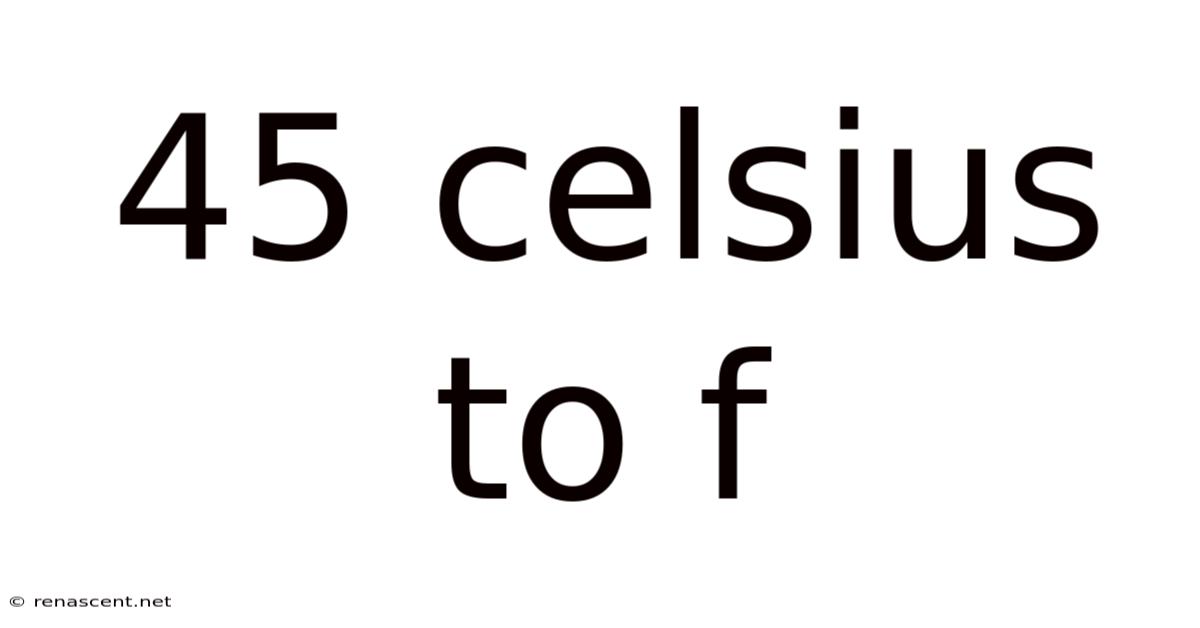45 Celsius To F
renascent
Sep 25, 2025 · 4 min read

Table of Contents
Converting Celsius to Fahrenheit: A Deep Dive into the 45°C to °F Conversion and Beyond
The seemingly simple task of converting Celsius to Fahrenheit often trips up even the most seasoned science enthusiasts. Understanding the process goes beyond just plugging numbers into a formula; it involves grasping the fundamental differences between these two temperature scales and appreciating their historical contexts. This article will not only guide you through converting 45° Celsius to Fahrenheit but also delve into the underlying principles, offer practical applications, and explore some common misconceptions surrounding temperature conversions. This comprehensive guide will equip you with the knowledge to confidently navigate temperature conversions in various scenarios.
Introduction: Understanding Temperature Scales
Before jumping into the 45°C to °F conversion, let's establish a firm understanding of the Celsius and Fahrenheit scales. Both are used to measure temperature, but they differ significantly in their reference points.
-
Celsius (°C): Also known as the centigrade scale, Celsius uses the freezing point of water (0°C) and the boiling point of water (100°C) at standard atmospheric pressure as its defining points. The scale is divided into 100 equal degrees between these two points. It's the most widely used temperature scale globally, particularly in scientific contexts.
-
Fahrenheit (°F): Developed by Daniel Gabriel Fahrenheit, this scale uses the freezing point of a brine solution (0°F) and the average human body temperature (approximately 98.6°F) as its original reference points. It's still prevalent in the United States, although its use is gradually decreasing internationally.
Converting 45°C to Fahrenheit: The Formula and Calculation
The conversion from Celsius (°C) to Fahrenheit (°F) is governed by a straightforward linear equation:
°F = (°C × 9/5) + 32
Let's apply this formula to convert 45°C to Fahrenheit:
°F = (45 × 9/5) + 32
°F = (81) + 32
°F = 113
Therefore, 45° Celsius is equivalent to 113° Fahrenheit.
Step-by-Step Guide to Celsius to Fahrenheit Conversion
To make the conversion process even clearer, let's break it down step-by-step:
- Multiply the Celsius temperature by 9/5 (or 1.8): This step scales the Celsius temperature to the Fahrenheit scale's broader range.
- Add 32: This step adjusts for the difference in the zero points of the two scales. Fahrenheit's zero point is significantly lower than Celsius'.
Practical Applications: Where Temperature Conversions Matter
The ability to convert between Celsius and Fahrenheit is crucial in many real-world situations:
- Cooking: Recipes often specify temperatures in either Celsius or Fahrenheit. Accurate conversions ensure successful cooking outcomes.
- Weather Forecasting: Understanding temperature in both scales helps people across different regions interpret weather reports effectively.
- Scientific Research: Scientists need to seamlessly switch between temperature scales depending on the context and the instruments used.
- Industrial Processes: Many industrial processes, like manufacturing and chemical engineering, rely on precise temperature control, demanding accurate conversions.
- Medical Applications: Body temperature readings, often taken in Celsius, might need to be converted to Fahrenheit for comparison with standard reference ranges in certain contexts.
Beyond 45°C: Exploring Other Conversions
While this article focuses on converting 45°C to °F, understanding the general formula allows you to convert any Celsius temperature to Fahrenheit. For instance:
- Converting 0°C to °F: (0 x 9/5) + 32 = 32°F (the freezing point of water)
- Converting 100°C to °F: (100 x 9/5) + 32 = 212°F (the boiling point of water)
- Converting -10°C to °F: (-10 x 9/5) + 32 = 14°F
The Scientific Explanation: Why the Formula Works
The conversion formula isn't arbitrary; it's rooted in the mathematical relationship between the Celsius and Fahrenheit scales. The factor 9/5 accounts for the difference in the size of the degrees between the two scales, while the addition of 32 adjusts for the different zero points. The linearity of the relationship means that a consistent change in Celsius will correspond to a consistent change in Fahrenheit.
Frequently Asked Questions (FAQ)
- Q: Can I convert Fahrenheit to Celsius? A: Absolutely! The reverse formula is: °C = (°F - 32) × 5/9
- Q: Why are there two different temperature scales? A: Historical reasons and differing scientific communities led to the development and continued use of both scales.
- Q: Which scale is more accurate? A: Both scales are equally accurate; the difference lies in their reference points and the size of their degrees.
- Q: Is there a temperature where Celsius and Fahrenheit are equal? A: Yes, at -40°C = -40°F. This is the only temperature where both scales coincide.
Conclusion: Mastering Temperature Conversions
Mastering Celsius to Fahrenheit conversions isn't merely about memorizing a formula; it's about gaining a deeper understanding of temperature scales and their significance. This knowledge is applicable across diverse fields, empowering you to tackle various challenges related to temperature measurement and interpretation. The detailed explanation and step-by-step guide provided in this article will enable you to confidently convert Celsius to Fahrenheit and vice versa, ensuring accuracy in various practical applications. Remember, understanding the why behind the formula is just as important as knowing the how. This comprehensive guide aims to bridge the gap between simply performing a calculation and deeply understanding the principles involved in temperature conversion, leading to a more robust understanding of the physical world around us.
Latest Posts
Latest Posts
-
1 2 Into A Fraction
Sep 25, 2025
-
86 Mph To Km
Sep 25, 2025
-
Animals In Murray River
Sep 25, 2025
-
Lad Language Acquisition Device
Sep 25, 2025
-
Coefficient Variation In Excel
Sep 25, 2025
Related Post
Thank you for visiting our website which covers about 45 Celsius To F . We hope the information provided has been useful to you. Feel free to contact us if you have any questions or need further assistance. See you next time and don't miss to bookmark.